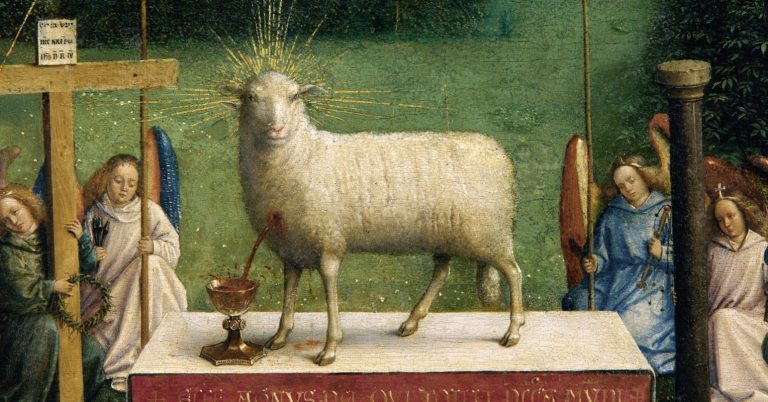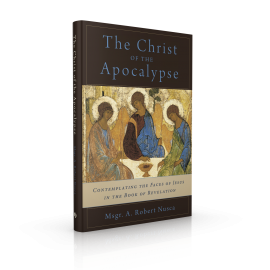By Robert Nusca
Msgr. Robert Nusca is the author of The Christ of the Apocalypse: Contemplating the Faces of Jesus in the Book of Revelation, a book that offers insight into one of the most misunderstood books of Scripture by uncovering the presence of Our Lord within its pages.

Beyond images of fire and falling stars, the Book of Revelation develops an elaborate portrait of a Christ with many Faces who stands at the center of life—on earth and in heaven—alongside God the Father Almighty in the power of the Holy Spirit. When taken together, John’s visions convey to the Churches of Asia Minor a remarkable preview of God’s world, where the heavenly throne of God and the Lamb stands at its very center. The story of this Apocalypse invites its audience not only to behold the symbolic universe that the text creates, but also to step with the author into that world of vision and to be transformed in the process. John’s aim is “not just to tell but to reveal” his Spirit-inspired visionary experience through the process of the community reading aloud and contemplating the text of the Apocalypse on the Lord’s day (likely within a worship setting; 1:3, 10). Whether the early Christian Eucharist may have been intended as the original setting (or what scholars refer to as the “theatre of reception”) for the reading aloud of the book remains an intriguing possibility that is not without support among commentators.
We should bear in mind that the first-century world of the Christians in Asia Minor is in turmoil. It is a time of crisis. It is a dangerous time—not unlike our own— in which there are “wars and rumors of wars” (Mt 24:6). False prophets abound (2 Pet 2:1) and the poor languish in the margins of society. Dominated by an empire whose symbols and values stand in stark opposition to those of the Gospel, it is a world in which God is not accorded His proper place at the center of life and human relationships. St. John has been banished to an island for his witness to the word of God (1:9). Facing a terrible situation personally and concerned for the faithful to whom he addresses his work, he offers his audience a glimpse into heaven through a door that has been opened by the Spirit (4:1ff.). Not unlike Jacob at Bethel, who was shown a stairway extending up into heaven (cf. Gen 28:11–16; Jn 1:51), John not only sees visions of God, but draws his readers with him into that world of vision, beginning in chapter 4. In a time of crisis it is given to an early Christian prophet to “draw back a veil” for his Churches (hence the name Apocalypse, from the Greek apocalypsis, a “disclosure,” an “unveiling,” or “re-velation”). And as the curtain is lifted, not only is John permitted to see what he describes, but those to whom the book is addressed are invited to look over his shoulder through the open door. The community that listens to the reading aloud of the book (1:3)—“on the Lord’s day” (1:10)—stands with the prophet at the “threshold of a new world,” God’s world—where “God triumphs over evil through the death of Jesus and the suffering of his followers.”
This “Apocalypse of Jesus Christ” (1:1) has been written not only to offer hope in the midst of crisis, but to give its readers an opportunity to view their own everyday world from a different perspective—a transcendent, God-centered perspective. Thus, John’s visions offer a place to stand above the sorrows, illusions, and confusion of this passing world, so as to provide clarity and perspective concerning their place in it. The audience is offered a viewpoint of this passing world “from the standpoint of heaven.” The day-to-day world (whether ancient Rome or postmodern Toronto or New York) looks very different when “opened to transcendence” and, thus, illuminated by the light of heaven. As such, the book does not merely reflect the first-century world of its author, it also “creates a world.”
In the interplay of opposing symbols within the Book of Revelation—images of heaven and earth, of the throne of God and the throne of Satan, of spiritual warfare between angels and devils, of the smoke of Babylon and the sparkling luster of the New Jerusalem—the faithful are offered a deeper insight concerning this passing world and their place in it. John’s visions offer his audience “a place on which to stand” in “an expanded universe.” The book offers “a set of Christian prophetic counter-images,” that inspire the reader “with alternative visions of how the world is and will be.” The division, indeed the “partitioning of humanity” into two diametrically opposed camps—the followers of God and the Lamb, and those allied with God’s opponents—is all part of the book’s art of persuasion, even as it reflects the belief that one’s eternal destiny is inextricably linked with the object of one’s worship in the present life. Thus, the audience is urged to worship God, and God alone: “To hold firm, to recognize the beast behind the beauty of Greco-Roman culture” and “to remain faithful witnesses.”
Throughout, John wants to bring us to the realization that the powers of the empire have no claim to finality. The destiny of the world is in the hands of God and the Lamb, good will triumph, sin and evil will come to an end, and the old order will pass away as all things are made new in Christ (21:5). Then as now, the faithful are invited to choose Christ and so to prepare to enter a new world: one that is already in the process of arriving through the life of prayer and the Spirit. We too are led to consider our own attitudes toward the political, economic, social, and technological forces that shape the globalized postmodern, post-national world in which we live.
You Might Also Like
 That the Apocalypse of John is a “Revelation of Jesus Christ” (Rev 1:1) is a fact too often overlooked by interpreters of this last book of the Bible. As Msgr. A. Robert Nusca’s The Christ of the Apocalypse: Contemplating the Faces of Jesus in the Book of Revelation proposes, beyond predictions of earthquakes and falling stars, St. John articulates from start to finish a multifaceted and compelling portrait of Jesus Christ.
That the Apocalypse of John is a “Revelation of Jesus Christ” (Rev 1:1) is a fact too often overlooked by interpreters of this last book of the Bible. As Msgr. A. Robert Nusca’s The Christ of the Apocalypse: Contemplating the Faces of Jesus in the Book of Revelation proposes, beyond predictions of earthquakes and falling stars, St. John articulates from start to finish a multifaceted and compelling portrait of Jesus Christ.

